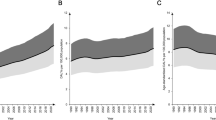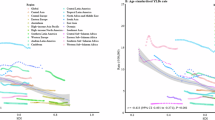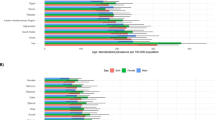Abstract
Background
Age-related macular degeneration (AMD) is a critical public health issue, requiring prioritized public health strategies.
Methods
Based on the Global Burden of Disease Study 2021, AMD burden and risk factors were analyzed, considering variables such as sex, age, and ___location. Age-standardized rates (ASR) were employed to evaluate and compare the burdens across different regions. Frontier analysis was used to determine the lowest achievable burden based on the Sociodemographic Index (SDI), while decomposition analysis revealed factors influencing age-related macular degeneration burden change.
Results
Globally, in 2021, ASR of prevalence and disability-adjusted life years (DALYs) were 94.00 (95% UI 78.32, 114.42) per 100,000 and 6.78 (95% UI 4.70, 9.32) per 100,000 respectively. Additionally, a reduction of smoking exposure to its theoretical minimum risk exposure level (TMREL) would lead to an estimated 10.0% decrease in AMD DALYs in 2021. Frontier analysis suggested that Nepal, Iran (Islamic Republic of), and Nigeria were the top three countries with the most substantial potential for reducing disparities. Decomposition analysis indicated that population growth and aging are the primary driving factors for the increase in AMD DALYs.
Conclusions
We identify countries and territories with potential for improvement and emphasize the importance of equitable, cost-effective control strategies, particularly tobacco control.
This is a preview of subscription content, access via your institution
Access options
Subscribe to this journal
Receive 18 print issues and online access
269,00 € per year
only 14,94 € per issue
Buy this article
- Purchase on SpringerLink
- Instant access to full article PDF
Prices may be subject to local taxes which are calculated during checkout





Similar content being viewed by others
Data availability
The dataset analyzed during the current study are available in the Institute for Health Metrics and Evaluation (IHME): http://ghdx.healthdata.org/gbd-results-tool.
References
GBD 2019 Blindness and Vision Impairment Collaborators.Causes of blindness and vision impairment in 2020 and trends over 30 years, and prevalence of avoidable blindness in relation to VISION 2020: the Right to Sight: an analysis for the Global Burden of Disease Study. Lancet Glob health. 2021;9:e144–e160. https://doi.org/10.1016/s2214-109x(20)30489-7.
Taylor DJ, Hobby AE, Binns AM, Crabb DP. How does age-related macular degeneration affect real-world visual ability and quality of life? A systematic review. BMJ open. 2016;6:e011504. https://doi.org/10.1136/bmjopen-2016-011504.
Age-related macular degeneration: facts & figures, BrightFocus Foundation. 2019. https://www.brightfocus.org/sources-macular-degeneration-facts-figures. Accessed 7 Mar 2025.
Zou M, Zhang Y, Chen A, Young CA, Li Y, Zheng D, et al. Variations and trends in global disease burden of age-related macular degeneration: 1990-2017. Acta Ophthalmol. 2021;99:e330–5. https://doi.org/10.1111/aos.14589.
Xu X, Wu J, Yu X, Tang Y, Tang X, Shentu X. Regional differences in the global burden of age-related macular degeneration. BMC Public Health. 2020;20:410. https://doi.org/10.1186/s12889-020-8445-y.
Chakravarthy U, Wong TY, Fletcher A, Piault E, Evans C, Zlateva G, et al. Clinical risk factors for age-related macular degeneration: a systematic review and meta-analysis. BMC Ophthalmol. 2010;10. https://doi.org/10.1186/1471-2415-10-31.
Wang D, Jiang Y, He M, Scheetz J, Wang W. Disparities in the global burden of age-related macular degeneration: an analysis of trends from 1990 to 2015. Curr Eye Res. 2019;44:657–63. https://doi.org/10.1080/02713683.2019.1576907.
Lin X, Lou L, Miao Q, Wang Y, Jin K, Shan P, et al. The pattern and gender disparity in global burden of age-related macular degeneration. Eur J Ophthalmol. 2021;31:1161–70. https://doi.org/10.1177/1120672120927256.
GBD 2021 Diseases and Injuries Collaborators.Global incidence, prevalence, years lived with disability (YLDs), disability-adjusted life-years (DALYs), and healthy life expectancy (HALE) for 371 diseases and injuries in 204 countries and territories and 811 subnational locations, 1990-2021: a systematic analysis for the Global Burden of Disease Study 2021. Lancet. 2024;403:2133–61. https://doi.org/10.1016/s0140-6736(24)00757-8.
GBD 2021 Risk Factors Collaborators.Global burden and strength of evidence for 88 risk factors in 204 countries and 811 subnational locations, 1990-2021: a systematic analysis for the Global Burden of Disease Study 2021. Lancet (Lond, Engl). 2024;403:2162–203. https://doi.org/10.1016/s0140-6736(24)00933-4.
Xie Y, Bowe B, Mokdad AH, Xian H, Yan Y, Li T, et al. Analysis of the Global Burden of Disease study highlights the global, regional, and national trends of chronic kidney disease epidemiology from 1990 to 2016. Kidney Int. 2018;94:567–81. https://doi.org/10.1016/j.kint.2018.04.011.
GBD 2017 Risk Factor Collaborators.Global, regional, and national comparative risk assessment of 84 behavioural, environmental and occupational, and metabolic risks or clusters of risks for 195 countries and territories, 1990-2017: a systematic analysis for the Global Burden of Disease Study 2017. Lancet (Lond, Engl). 2018;392:1923–94. https://doi.org/10.1016/s0140-6736(18)32225-6.
Wong WL, Su X, Li X, Cheung CM, Klein R, Cheng CY, et al. Global prevalence of age-related macular degeneration and disease burden projection for 2020 and 2040: a systematic review and meta-analysis. Lancet Glob health. 2014;2:e106–116. https://doi.org/10.1016/s2214-109x(13)70145-1.
Yang X, Chen H, Zhang T, Yin X, Man J, He Q, et al. Global, regional, and national burden of blindness and vision loss due to common eye diseases along with its attributable risk factors from 1990 to 2019: a systematic analysis from the global burden of disease study 2019. Aging. 2021;13:19614–42. https://doi.org/10.18632/aging.203374.
Jiang B, Jiang C, Li J, Lu P. Trends and disparities in disease burden of age-related macular degeneration from 1990 to 2019: Results from the global burden of disease study 2019. Front public health. 2023;11:1138428. https://doi.org/10.3389/fpubh.2023.1138428.
WHO. Ageing and health. https://www.who.int/news-room/fact-sheets/detail/ageing-and-health.
UN. Envision 2030: 17 goals to transform the world for persons with disabilities. https://www.un.org/development/desa/disabilities/envision2030.html. Accessed 13 Apr 2022.
Kahloun R, Khairallah M, Resnikoff S, Cicinelli MV, Flaxman SR, Das A, et al. Prevalence and causes of vision loss in North Africa and Middle East in 2015: magnitude, temporal trends and projections. Br J Ophthalmol. 2019;103:863–70. https://doi.org/10.1136/bjophthalmol-2018-312068.
Khairallah M, Kahloun R, Flaxman SR, Jonas JB, Keeffe J, Leasher J, et al. Prevalence and causes of vision loss in North Africa and the Middle East: 1990-2010. Br J Ophthalmol. 2014;98:605–11. https://doi.org/10.1136/bjophthalmol-2013-304068.
Joachim N, Mitchell P, Burlutsky G, Kifley A, Wang JJ. The incidence and progression of age-related macular degeneration over 15 years: the blue mountains eye study. Ophthalmology. 2015;122:2482–9. https://doi.org/10.1016/j.ophtha.2015.08.002.
Keenan TD, Agrón E, Domalpally A, Clemons TE, van Asten F, Wong WT, et al. Progression of geographic atrophy in age-related macular degeneration: AREDS2 report number 16. Ophthalmology. 2018;125:1913–28. https://doi.org/10.1016/j.ophtha.2018.05.028.
Willeford KT, Rapp J. Smoking and age-related macular degeneration: biochemical mechanisms and patient support. Optom Vis Sci. 2012;89:1662–6. https://doi.org/10.1097/OPX.0b013e31826c5df2.
Chung-Hall J, Craig L, Gravely S, Sansone N, Fong GT. Impact of the WHO FCTC over the first decade: a global evidence review prepared for the Impact Assessment Expert Group. Tob control. 2019;28:s119–28. https://doi.org/10.1136/tobaccocontrol-2018-054389.
Flor LS, Reitsma MB, Gupta V, Ng M, Gakidou E. The effects of tobacco control policies on global smoking prevalence. Nat Med. 2021;27:239–43. https://doi.org/10.1038/s41591-020-01210-8.
Mehta MC, Narayanan R, Thomas Aretz H, Khanna R, Rao GN. The L V Prasad Eye Institute: a comprehensive case study of excellent and equitable eye care. Healthcare. 2020;8:100408. https://doi.org/10.1016/j.hjdsi.2019.100408.
Acknowledgements
Thanks to the Institute for Health Metrics and Evaluation, the World Health Organization, the World Bank, and the International Labor Organization for making data public.
Author information
Authors and Affiliations
Contributions
ZZ conceptualized the study, curated and analyzed data, developed methodology and software, validated results, visualized findings, and drafted and revised the manuscript. XZ conducted formal analysis, implemented software, and created visualizations. RZ contributed to study conceptualization and critically reviewed/edited the manuscript. CT visualized data, wrote the initial draft, and revised the manuscript. JB validated results, curated data, and created visualizations. PZ curated data, contributed to methodology development, and visualized findings. SY conceptualized the study and validated results. YG oversaw conceptualization, administered the project, supervised research activities, and validated outcomes. All authors approved the final version for publication and agree to accountability for all aspects of the work.
Corresponding authors
Ethics declarations
Competing interests
The authors declare no competing interests.
Ethics approval
The study has been evaluated by the Ethics Committee of the Aerospace Center Hospital and deemed not to require ethics approval.
Additional information
Publisher’s note Springer Nature remains neutral with regard to jurisdictional claims in published maps and institutional affiliations.
Supplementary information
Rights and permissions
Springer Nature or its licensor (e.g. a society or other partner) holds exclusive rights to this article under a publishing agreement with the author(s) or other rightsholder(s); author self-archiving of the accepted manuscript version of this article is solely governed by the terms of such publishing agreement and applicable law.
About this article
Cite this article
Zhang, Z., Zhang, X., Zhang, R. et al. Potential to improve the burden of age-related macular degeneration: results from the Global Burden of Disease Study 2021. Eye 39, 2064–2072 (2025). https://doi.org/10.1038/s41433-025-03786-2
Received:
Revised:
Accepted:
Published:
Issue Date:
DOI: https://doi.org/10.1038/s41433-025-03786-2



